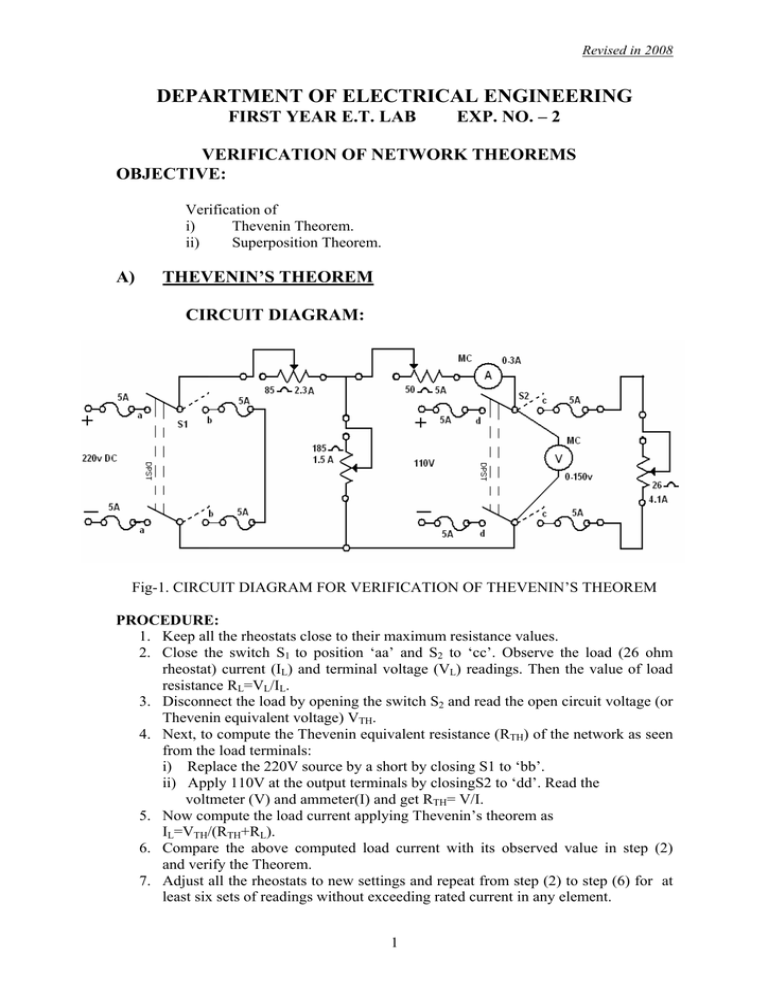Manual - Department of Electrical Engineering
advertisement

Revised in 2008 DEPARTMENT OF ELECTRICAL ENGINEERING FIRST YEAR E.T. LAB EXP. NO. – 2 VERIFICATION OF NETWORK THEOREMS OBJECTIVE: Verification of i) Thevenin Theorem. ii) Superposition Theorem. A) THEVENIN’S THEOREM CIRCUIT DIAGRAM: Fig-1. CIRCUIT DIAGRAM FOR VERIFICATION OF THEVENIN’S THEOREM PROCEDURE: 1. Keep all the rheostats close to their maximum resistance values. 2. Close the switch S1 to position ‘aa’ and S2 to ‘cc’. Observe the load (26 ohm rheostat) current (IL) and terminal voltage (VL) readings. Then the value of load resistance RL=VL/IL. 3. Disconnect the load by opening the switch S2 and read the open circuit voltage (or Thevenin equivalent voltage) VTH. 4. Next, to compute the Thevenin equivalent resistance (RTH) of the network as seen from the load terminals: i) Replace the 220V source by a short by closing S1 to ‘bb’. ii) Apply 110V at the output terminals by closingS2 to ‘dd’. Read the voltmeter (V) and ammeter(I) and get RTH= V/I. 5. Now compute the load current applying Thevenin’s theorem as IL=VTH/(RTH+RL). 6. Compare the above computed load current with its observed value in step (2) and verify the Theorem. 7. Adjust all the rheostats to new settings and repeat from step (2) to step (6) for at least six sets of readings without exceeding rated current in any element. 1 Revised in 2008 Table – I Thevenin’s Theorem Sl. Observed No. Load Current IL VL RL = VL/IL VTH (V) V (V) I (A) RTH = V/I (Ω) Computed load Current (A) VTH/(RTH+RL)=IL DISCUSSION: (i) (ii) (iii) (iv) Why are you applying 110 V instead of 220 V while finding RTH? Can you suggest an alternative procedure for the determination of RTH? Is there any restriction for choice of circuit elements? What type of ammeter and voltmeter (MC or MI) will you use and why? B) SUPERPOSITION THEOREM CIRCUIT DIAGRAM FIG:2 CIRCUIT DIAGRAM FOR VERIFICATION OF SUPERPOSITION THEOREM 2 Revised in 2008 PROCEDURE: i) ii) iii) iv) v) vi) vii) Connect the circuit as shown in the diagram, keeping the switches open and resistances at their maximum positions. Set S1 to position ‘aa’ and S2 to position ‘cc’ respectively which means both the sources are energized. Note down the currents I1, I2 and I3 from the ammeter. A1, A2 and A3. Set S1 on position ‘aa’ and S2 on position ‘dd’ respectively, i.e. only 220 V source is energized and the terminals of S2 are shorted. Note down the current I1ʹ, I2ʹand I3ʹ. Set S1 to position ‘bb’ and S2 to position ‘cc’ respectively and note I1ʺ, I2ʺ and I3ʺ. [Please note the polarity of the currents] Compare I1, I2 and I3 with (I1ʹ+I1ʺ), (I2ʹ+I2ʺ) and (I3ʹ+I3ʺ) taking care of the signs properly to verify the theorem. Repeat this from step (ii) to (v) for three different sets of resistance value of the three rheostats. Tabulate the results as shown. Table – II Superposition Theorem Sl. No 1. Step 1 I1= Step 2 I1ʹ = Step 3 I1ʺ = Computed currents I1c=I1ʹ+I1ʺ = Error % Error ΔI1=I1-I1c = (ΔI1 / I1)100 = I2= I2ʹ = I2ʺ = I2c =I2ʹ+I2ʺ = ΔI2 = I2-I2c = (ΔI2 / I2)100 = I3= I3ʹ = I3ʺ = I3c = I3ʹ+I3ʺ = ΔI3=I3-I3c = (ΔI3 / I3)100 = 2. DISCUSSION: i) ii) iii) iv) What type of ammeters (MI or MC) will you choose? While considering the effect of a single source, the other source is short circuited why? How far is it justified? Why are you noting the direction of the deflection of the meter? If the rheostats are replaced by three incandescent lamps, can you verify the theorem? 3



